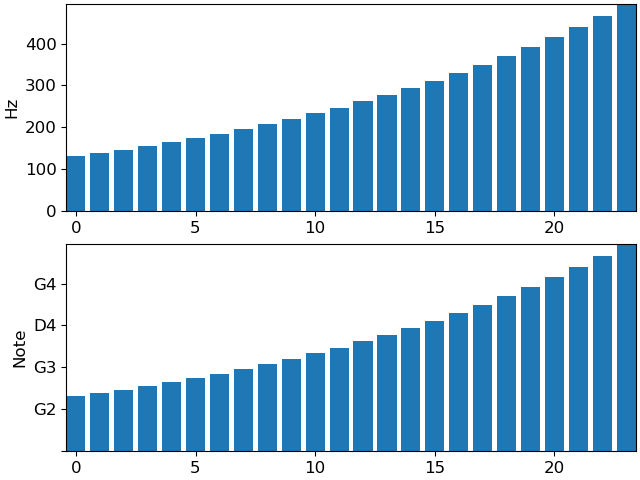Caution
You're reading an old version of this documentation. If you want up-to-date information, please have a look at 0.10.2.
librosa.display.FJSFormatter
- class librosa.display.FJSFormatter(*, fmin, n_bins, bins_per_octave, intervals, major=True, unison=None, unicode=True)[source]
Ticker formatter for Functional Just System (FJS) notation
- Parameters:
- fminfloat
The unison frequency for this axis
- intervalsstr or array of float in [1, 2)
The interval specification for the frequency axis.
See
core.interval_frequenciesfor supported values.- majorbool
If
True, ticks are always labeled.If
False, ticks are only labeled if the span is less than 2 octaves- unisonstr
The unison note name. If not provided, it will be inferred from fmin.
- unicodebool
If
True, use unicode symbols for accidentals.If
False, use ASCII symbols for accidentals.
See also
NoteFormatterhz_to_fjsmatplotlib.ticker.Formatter
Examples
>>> import matplotlib.pyplot as plt >>> values = librosa.midi_to_hz(np.arange(48, 72)) >>> fig, ax = plt.subplots(nrows=2) >>> ax[0].bar(np.arange(len(values)), values) >>> ax[0].set(ylabel='Hz') >>> ax[1].bar(np.arange(len(values)), values) >>> ax[1].yaxis.set_major_formatter(librosa.display.NoteFormatter()) >>> ax[1].set(ylabel='Note')

- __init__(*, fmin, n_bins, bins_per_octave, intervals, major=True, unison=None, unicode=True)[source]
Methods
__init__(*, fmin, n_bins, bins_per_octave, ...)create_dummy_axis(**kwargs)fix_minus(s)Some classes may want to replace a hyphen for minus with the proper Unicode symbol (U+2212) for typographical correctness. This is a helper method to perform such a replacement when it is enabled via :rc:`axes.unicode_minus`.
format_data(value)Return the full string representation of the value with the position unspecified.
format_data_short(value)Return a short string version of the tick value.
format_ticks(values)Return the tick labels for all the ticks at once.
get_offset()set_axis(axis)set_locs(locs)Set the locations of the ticks.
Attributes
axislocs